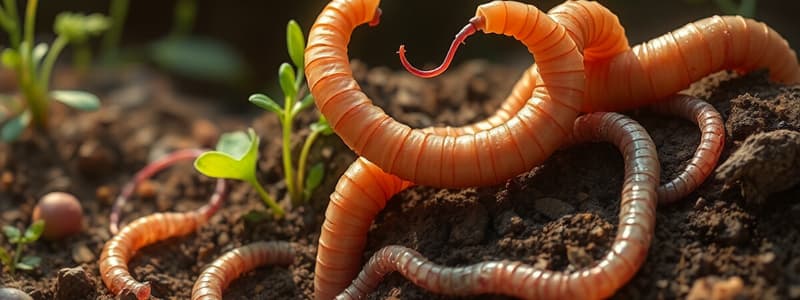Podcast
Questions and Answers
What is the primary benefit of the rhizosphere in soil ecology?
What is the primary benefit of the rhizosphere in soil ecology?
- It enhances the biological and chemical interactions around plant roots. (correct)
- It reduces soil temperature significantly.
- It prevents the growth of competing plant species.
- It increases soil salinity levels.
Which of the following factors is essential for achieving optimal soil biomass?
Which of the following factors is essential for achieving optimal soil biomass?
- High soil temperature and low organic matter.
- Moist soil, pH between 6-8, and high organic matter. (correct)
- A pH level consistently above 9.
- Dry conditions with frequent droughts.
In what process do bacteria convert atmospheric nitrogen into a usable form for plants, and what is one of the subsequent steps?
In what process do bacteria convert atmospheric nitrogen into a usable form for plants, and what is one of the subsequent steps?
- Ammonification develops atmospheric nitrogen directly from urea.
- Nitrification converts NH4+ to NO3-. (correct)
- Nitrogen fixation results in the creation of NH4+ from nitrates.
- Denitrification converts NO2- back to N2.
How do mycorrhizal fungi primarily enhance soil fertility?
How do mycorrhizal fungi primarily enhance soil fertility?
Which of the following agricultural practices helps farmers reduce their carbon footprint?
Which of the following agricultural practices helps farmers reduce their carbon footprint?
What is the ideal pH range for earthworms to thrive in soil?
What is the ideal pH range for earthworms to thrive in soil?
What is the purpose of adding farmyard manure (FYM) to the soil in terms of earthworm health?
What is the purpose of adding farmyard manure (FYM) to the soil in terms of earthworm health?
What is the term for the total amount of organic matter living in the soil?
What is the term for the total amount of organic matter living in the soil?
How do mycorrhizal fungi benefit plants in their symbiotic relationship?
How do mycorrhizal fungi benefit plants in their symbiotic relationship?
What is the primary role of rhizobium bacteria in the nitrogen cycle?
What is the primary role of rhizobium bacteria in the nitrogen cycle?
What is the main benefit of eco-tillage and minimum tillage practices for reducing carbon footprint?
What is the main benefit of eco-tillage and minimum tillage practices for reducing carbon footprint?
What is the primary function of soil bacteria in soil fertility?
What is the primary function of soil bacteria in soil fertility?
How do legume plants utilize nitrogen from the soil with the help of rhizobium bacteria?
How do legume plants utilize nitrogen from the soil with the help of rhizobium bacteria?
What is the main outcome of denitrifying bacteria acting in anaerobic conditions?
What is the main outcome of denitrifying bacteria acting in anaerobic conditions?
What distinguishes nitrogen fixation from nitrification in the nitrogen cycle?
What distinguishes nitrogen fixation from nitrification in the nitrogen cycle?
In what way do microorganisms support the nitrogen cycle through organic matter decomposition?
In what way do microorganisms support the nitrogen cycle through organic matter decomposition?
What role does minimum tillage play in soil carbon dynamics?
What role does minimum tillage play in soil carbon dynamics?
What process do Nitrosomas bacteria facilitate in the nitrogen cycle?
What process do Nitrosomas bacteria facilitate in the nitrogen cycle?
How does soil disturbance affect the carbon cycle?
How does soil disturbance affect the carbon cycle?
What is the primary difference between nitrite and nitrate in the nitrogen cycle?
What is the primary difference between nitrite and nitrate in the nitrogen cycle?
What is the function of bacteria concerning soil fertility?
What is the function of bacteria concerning soil fertility?
How do rhizobium bacteria benefit legume plants specifically?
How do rhizobium bacteria benefit legume plants specifically?
What key function does the rhizosphere serve in soil ecology?
What key function does the rhizosphere serve in soil ecology?
Which condition is NOT necessary for optimal soil biomass?
Which condition is NOT necessary for optimal soil biomass?
Which of the following describes the role of bacteria in the nitrogen cycle?
Which of the following describes the role of bacteria in the nitrogen cycle?
How do mycorrhizal fungi improve disease resistance in plants?
How do mycorrhizal fungi improve disease resistance in plants?
Which practice is least effective for reducing a farmer's carbon footprint?
Which practice is least effective for reducing a farmer's carbon footprint?
What is the primary role of microorganisms in the soil?
What is the primary role of microorganisms in the soil?
Which statement best describes the relationship between mycorrhizal fungi and plants?
Which statement best describes the relationship between mycorrhizal fungi and plants?
What benefit does the addition of earthworm feces provide to soil fertility?
What benefit does the addition of earthworm feces provide to soil fertility?
How do farmers achieve reduced carbon emissions through specific tillage practices?
How do farmers achieve reduced carbon emissions through specific tillage practices?
What is the significance of the rhizosphere in soil ecology?
What is the significance of the rhizosphere in soil ecology?
What does the term carbon footprint refer to in agriculture?
What does the term carbon footprint refer to in agriculture?
What is the primary form of nitrogen that rhizobium bacteria convert during the nitrogen fixation process?
What is the primary form of nitrogen that rhizobium bacteria convert during the nitrogen fixation process?
What is the outcome of reducing soil disturbance with practices like minimum tillage?
What is the outcome of reducing soil disturbance with practices like minimum tillage?
Which bacteria converts ammonium (NH4) into nitrite (NO2-) during nitrification?
Which bacteria converts ammonium (NH4) into nitrite (NO2-) during nitrification?
Under which environmental condition do denitrifying bacteria thrive?
Under which environmental condition do denitrifying bacteria thrive?
What is nitrogen fixation?
What is nitrogen fixation?
What crucial role do microorganisms play in the nitrogen cycle?
What crucial role do microorganisms play in the nitrogen cycle?
How do legume plants primarily utilize nitrogen with the help of rhizobium bacteria?
How do legume plants primarily utilize nitrogen with the help of rhizobium bacteria?
What process distinguishes nitrification from nitrogen fixation?
What process distinguishes nitrification from nitrogen fixation?
What is a key impact of soil disturbance on the carbon cycle?
What is a key impact of soil disturbance on the carbon cycle?
Which statement accurately describes the role of bacteria in enhancing soil fertility?
Which statement accurately describes the role of bacteria in enhancing soil fertility?
What distinguishes nitrite (NO2-) from nitrate (NO3-) in terms of their roles in the nitrogen cycle?
What distinguishes nitrite (NO2-) from nitrate (NO3-) in terms of their roles in the nitrogen cycle?
What is the main benefit of earthworms decomposing organic matter in soil?
What is the main benefit of earthworms decomposing organic matter in soil?
How does organic matter contribute to the soil's carbon footprint?
How does organic matter contribute to the soil's carbon footprint?
Which process is primarily facilitated by bacteria in the soil that can also transform nitrogen into a usable form for plants?
Which process is primarily facilitated by bacteria in the soil that can also transform nitrogen into a usable form for plants?
What role do mycorrhizal fungi play in the nutrient exchange with plants?
What role do mycorrhizal fungi play in the nutrient exchange with plants?
What factor is crucial for maintaining soil biomass and supporting the ecological balance?
What factor is crucial for maintaining soil biomass and supporting the ecological balance?
What defines the term 'rhizosphere' in soil ecology?
What defines the term 'rhizosphere' in soil ecology?
What negative consequence could arise from excessive soil disturbance in terms of the carbon cycle?
What negative consequence could arise from excessive soil disturbance in terms of the carbon cycle?
How do earthworms specifically contribute to soil fertility?
How do earthworms specifically contribute to soil fertility?
What is a critical benefit provided by mycorrhizal fungi that supports plant-soil interactions?
What is a critical benefit provided by mycorrhizal fungi that supports plant-soil interactions?
What primary environmental conditions must be met for microorganisms to thrive in soil, influencing the carbon cycle?
What primary environmental conditions must be met for microorganisms to thrive in soil, influencing the carbon cycle?
Which nutrient cycling process directly involves bacteria converting ammonium into nitrate, crucial for plant uptake?
Which nutrient cycling process directly involves bacteria converting ammonium into nitrate, crucial for plant uptake?
What is the main impact of minimum tillage practices on soil health and carbon storage?
What is the main impact of minimum tillage practices on soil health and carbon storage?
How does reducing soil disturbance specifically influence the soil microbiome?
How does reducing soil disturbance specifically influence the soil microbiome?
What is the primary distinction between nitrification and nitrogen fixation in the nitrogen cycle?
What is the primary distinction between nitrification and nitrogen fixation in the nitrogen cycle?
Under what specific conditions do denitrifying bacteria operate effectively?
Under what specific conditions do denitrifying bacteria operate effectively?
What nutrients are typically released by microorganisms as they decompose organic matter in soil?
What nutrients are typically released by microorganisms as they decompose organic matter in soil?
Which statement accurately reflects the interaction between legume plants and rhizobium bacteria?
Which statement accurately reflects the interaction between legume plants and rhizobium bacteria?
What role does the process of nitrification play in soil health?
What role does the process of nitrification play in soil health?
What is one major implication of intensive soil disturbance for carbon storage in soils?
What is one major implication of intensive soil disturbance for carbon storage in soils?
Which of the following processes is specifically associated with Nitrosomas bacteria in the nitrogen cycle?
Which of the following processes is specifically associated with Nitrosomas bacteria in the nitrogen cycle?
What is the significance of minimum tillage concerning soil's carbon cycle dynamics?
What is the significance of minimum tillage concerning soil's carbon cycle dynamics?
What key nutrient does ammonium get converted into during the process of nitrification?
What key nutrient does ammonium get converted into during the process of nitrification?
Flashcards are hidden until you start studying
Study Notes
Soil Conditions for Earthworms and Microorganisms
- Ideal pH range for earthworms: 6-8, promoting optimal health and activity.
- Farmyard manure (FYM) serves as food for earthworms, increasing their population and enhancing soil structure.
- Soil biomass refers to the total organic matter living in soil, essential for fertility.
Microbial Activities and the Carbon Cycle
- Primary role of microorganisms in the decay process: breaking down organic matter, releasing carbon dioxide (CO2) into the atmosphere.
- Key contributions to soil fertility include decomposing organic matter and converting nutrients into usable forms.
- Soil disturbance can release carbon into the atmosphere, exacerbating climate change; practices like minimum tillage can mitigate this.
Nitrogen Cycle Dynamics
- Rhizobium bacteria convert nitrogen gas (N2) into nitrate (NO3-) for plant uptake, pivotal for nitrogen fixation in legumes.
- Nitrification process: Ammonium (NH4) is converted to nitrite (NO2-) by Nitrosomonas bacteria.
- Denitrifying bacteria thrive in anaerobic conditions, converting nitrate (NO3-) back to atmospheric nitrogen (N2).
Symbiotic Relationships and Soil Fertility
- Mycorrhizal fungi and plants exist in a mutualistic relationship, providing water, nutrients, and disease resistance to the plant while receiving carbohydrates in return.
- The rhizosphere is where biological and chemical interactions are influenced by plant roots, crucial for nutrient exchange.
- Reducing soil disturbance through practices like eco-tillage supports carbon storage and enhances soil health.
Impact of Soil Health on Ecosystems
- Soil organic matter contains approximately 58% organic carbon, playing a critical role in maintaining soil fertility.
- Microorganisms contribute to the nitrogen cycle by recycling nutrients, fostering plant growth and ecosystem functioning.
- Optimal conditions for soil microorganisms include well-aerated, warm (above 10°C) and moist soil, which supports efficient decomposition and nutrient availability.
Sustainable Agriculture Practices
- Farmers can reduce their carbon footprint by implementing sustainable practices such as minimal tillage, tree planting, and utilizing biofuels.
- These agricultural strategies conserve energy, lower emissions, and enhance carbon sequestration in soil.
- Soil Organic Carbon (SOC) is a key indicator of soil health; calculations involve assessing the carbon content in soil organic matter to evaluate fertility and ecological health.
Soil Conditions for Earthworms and Microorganisms
- Ideal pH range for earthworms: 6-8, promoting optimal health and activity.
- Farmyard manure (FYM) serves as food for earthworms, increasing their population and enhancing soil structure.
- Soil biomass refers to the total organic matter living in soil, essential for fertility.
Microbial Activities and the Carbon Cycle
- Primary role of microorganisms in the decay process: breaking down organic matter, releasing carbon dioxide (CO2) into the atmosphere.
- Key contributions to soil fertility include decomposing organic matter and converting nutrients into usable forms.
- Soil disturbance can release carbon into the atmosphere, exacerbating climate change; practices like minimum tillage can mitigate this.
Nitrogen Cycle Dynamics
- Rhizobium bacteria convert nitrogen gas (N2) into nitrate (NO3-) for plant uptake, pivotal for nitrogen fixation in legumes.
- Nitrification process: Ammonium (NH4) is converted to nitrite (NO2-) by Nitrosomonas bacteria.
- Denitrifying bacteria thrive in anaerobic conditions, converting nitrate (NO3-) back to atmospheric nitrogen (N2).
Symbiotic Relationships and Soil Fertility
- Mycorrhizal fungi and plants exist in a mutualistic relationship, providing water, nutrients, and disease resistance to the plant while receiving carbohydrates in return.
- The rhizosphere is where biological and chemical interactions are influenced by plant roots, crucial for nutrient exchange.
- Reducing soil disturbance through practices like eco-tillage supports carbon storage and enhances soil health.
Impact of Soil Health on Ecosystems
- Soil organic matter contains approximately 58% organic carbon, playing a critical role in maintaining soil fertility.
- Microorganisms contribute to the nitrogen cycle by recycling nutrients, fostering plant growth and ecosystem functioning.
- Optimal conditions for soil microorganisms include well-aerated, warm (above 10°C) and moist soil, which supports efficient decomposition and nutrient availability.
Sustainable Agriculture Practices
- Farmers can reduce their carbon footprint by implementing sustainable practices such as minimal tillage, tree planting, and utilizing biofuels.
- These agricultural strategies conserve energy, lower emissions, and enhance carbon sequestration in soil.
- Soil Organic Carbon (SOC) is a key indicator of soil health; calculations involve assessing the carbon content in soil organic matter to evaluate fertility and ecological health.
Soil Conditions for Earthworms and Microorganisms
- Ideal pH range for earthworms: 6-8, promoting optimal health and activity.
- Farmyard manure (FYM) serves as food for earthworms, increasing their population and enhancing soil structure.
- Soil biomass refers to the total organic matter living in soil, essential for fertility.
Microbial Activities and the Carbon Cycle
- Primary role of microorganisms in the decay process: breaking down organic matter, releasing carbon dioxide (CO2) into the atmosphere.
- Key contributions to soil fertility include decomposing organic matter and converting nutrients into usable forms.
- Soil disturbance can release carbon into the atmosphere, exacerbating climate change; practices like minimum tillage can mitigate this.
Nitrogen Cycle Dynamics
- Rhizobium bacteria convert nitrogen gas (N2) into nitrate (NO3-) for plant uptake, pivotal for nitrogen fixation in legumes.
- Nitrification process: Ammonium (NH4) is converted to nitrite (NO2-) by Nitrosomonas bacteria.
- Denitrifying bacteria thrive in anaerobic conditions, converting nitrate (NO3-) back to atmospheric nitrogen (N2).
Symbiotic Relationships and Soil Fertility
- Mycorrhizal fungi and plants exist in a mutualistic relationship, providing water, nutrients, and disease resistance to the plant while receiving carbohydrates in return.
- The rhizosphere is where biological and chemical interactions are influenced by plant roots, crucial for nutrient exchange.
- Reducing soil disturbance through practices like eco-tillage supports carbon storage and enhances soil health.
Impact of Soil Health on Ecosystems
- Soil organic matter contains approximately 58% organic carbon, playing a critical role in maintaining soil fertility.
- Microorganisms contribute to the nitrogen cycle by recycling nutrients, fostering plant growth and ecosystem functioning.
- Optimal conditions for soil microorganisms include well-aerated, warm (above 10°C) and moist soil, which supports efficient decomposition and nutrient availability.
Sustainable Agriculture Practices
- Farmers can reduce their carbon footprint by implementing sustainable practices such as minimal tillage, tree planting, and utilizing biofuels.
- These agricultural strategies conserve energy, lower emissions, and enhance carbon sequestration in soil.
- Soil Organic Carbon (SOC) is a key indicator of soil health; calculations involve assessing the carbon content in soil organic matter to evaluate fertility and ecological health.
Studying That Suits You
Use AI to generate personalized quizzes and flashcards to suit your learning preferences.





